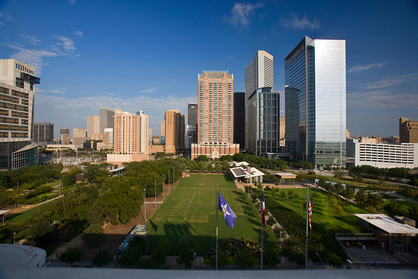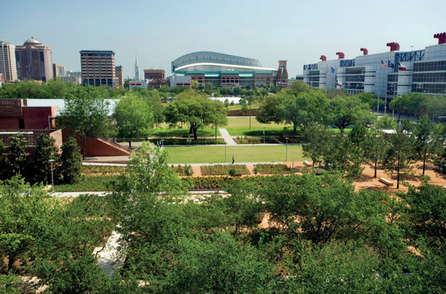Discovery Green - Houston, TX
Discovery Green is a 12-acre park located in the heart of downtown Houston. It lies in the shadow of the city's skyline and is one of the few public green spaces within the densely developed area. It is a positive example to follow on numerous fronts. First, the park was the result of a public-private partnership that is often so essential in the creation of such a project. The park was also just recently created in 2008, which is symbolic of the growing favorable attitude towards the importance of providing adequate green space within urban areas. Finally, the park reclaimed under-used and unattractive land, as it was built on the site of two large surface parking lots. Now, downtown Houston has a tranquil and large park within the business heart of the city.
The park is the result of a vision that was put into action by several well-connected Houston philanthropists. Their wish was to transform the landscape of downtown into something more livable and vibrant. They seized the opportunity of developing an undeveloped site used for parking into a valuable park space that would promote the quality of life and business opportunities within the neighborhood. On all sides, the park is surrounded by dense development, including the George R. Brown Convention Center, which holds a large concentration of out-of-town visitors on any given day. Therefore, the park is a destination for residents, tourists, and business travelers alike. It has become nearly exactly what the minds behind the park had envisioned when they began their development efforts. They realized the potential of the land as it had not always been in such an under-used condition. In fact, it was originally the site of a high-end residential neighborhood in the early 20th century that grew less attractive over time. As the residential area deteriorated and dense downtown development dominated, the area was cleared and parking lots were put in place to accommodate automobile culture.
In 2002, the city of Houston purchased a portion of the land. Shortly thereafter, the rest of the site's property went up for sale, and a the group of philanthropists approached the city with the idea of turning the site into a park. The city agreed and, in 2004, purchased the remainder of the site while advocating the merits of a public-private partnership. The city agreed to provide funding and support for the park, while handing over operational controls to Discovery Green Conservancy, a nonprofit organization. In the design process for the park, the public played a pivotal role. The current state and design of the park is largely a result of this public process. As a result, the park has been showered with rave from the general public.
In the end, the park, while new, has been an enormous success. It is a catalyst for changing the perception of downtown Houston. It is now a place to enjoy and play, besides being a neighborhood strictly for business. It has increased civic pride in the area and people have less of an incentive to jet away from downtown at the end of the work day. It is also the result of great cooperation and follow-through among the public and partnering entities. It shows what can be accomplished if several strands of a community share a vision and have the initiative to implement it.
The park is the result of a vision that was put into action by several well-connected Houston philanthropists. Their wish was to transform the landscape of downtown into something more livable and vibrant. They seized the opportunity of developing an undeveloped site used for parking into a valuable park space that would promote the quality of life and business opportunities within the neighborhood. On all sides, the park is surrounded by dense development, including the George R. Brown Convention Center, which holds a large concentration of out-of-town visitors on any given day. Therefore, the park is a destination for residents, tourists, and business travelers alike. It has become nearly exactly what the minds behind the park had envisioned when they began their development efforts. They realized the potential of the land as it had not always been in such an under-used condition. In fact, it was originally the site of a high-end residential neighborhood in the early 20th century that grew less attractive over time. As the residential area deteriorated and dense downtown development dominated, the area was cleared and parking lots were put in place to accommodate automobile culture.
In 2002, the city of Houston purchased a portion of the land. Shortly thereafter, the rest of the site's property went up for sale, and a the group of philanthropists approached the city with the idea of turning the site into a park. The city agreed and, in 2004, purchased the remainder of the site while advocating the merits of a public-private partnership. The city agreed to provide funding and support for the park, while handing over operational controls to Discovery Green Conservancy, a nonprofit organization. In the design process for the park, the public played a pivotal role. The current state and design of the park is largely a result of this public process. As a result, the park has been showered with rave from the general public.
In the end, the park, while new, has been an enormous success. It is a catalyst for changing the perception of downtown Houston. It is now a place to enjoy and play, besides being a neighborhood strictly for business. It has increased civic pride in the area and people have less of an incentive to jet away from downtown at the end of the work day. It is also the result of great cooperation and follow-through among the public and partnering entities. It shows what can be accomplished if several strands of a community share a vision and have the initiative to implement it.


